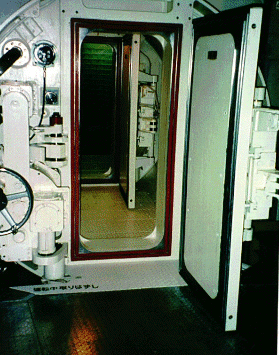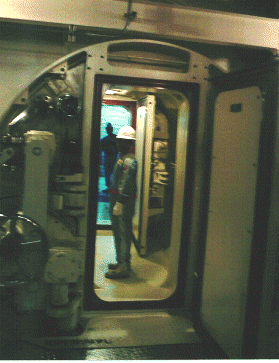
Photo by J.A. Gonyeau

Photo by J.A. Gonyeau
Containment Airlocks
All containments are designed to contain radioactive materials, if released from the reactor cooling system, and maintain the pressure less than the design pressure. The containment has several entrances - some designed just for personnel, others for maintenance equipment. In addition, there are usually equipment hatches that may be used to insert or remove very large components, e.g. the steam generators.
 Photo by J.A. Gonyeau |
 Photo by J.A. Gonyeau |
These photos illustrate the typical personnel hatch. The containment entrances have double hatches as barriers. The right hand photo shows the relative size of a person passing through the entrance. During special situations when the unit is shutdown, both hatches may be open at the same time as shown in the picture. However, during operation both hatches are closed (and access to the containment is locked).
During plant operation, PWR containment entries are made infrequently (e.g. once a week or several weeks). There are numerous instruments that monitor for leakage from any of the radioactive and non-radioactive systems, thus, entries are not required on a routine basis. When entries are made into containment during plant operation, access is not allowed into those areas of high radiation dose rates - near the reactor, reactor cooling loop, steam generator, reactor coolant pump, or pressurizer. As shown in some of the other pages on this site, this equipment is located in shielded compartments so that radiation dose rates and subsequent radiation exposures is low. In some cases, supervisors, health phusicists, and maintenance personnel must make entries to inspect or perform required preventive maintenance (e.g. lubrication) on equipment located in the containment (e.g. containment cooling units, valves, other piping systems).
Boiling water reactor drywells are often pressurized with nitrogen so entries are not made.
However, in either plant type, detection of low levels of leakage - radioactive or non-radioactive - would result in an inspection being made to determine the cause and correct it.
Copyright © 1996-2004. Joseph Gonyeau, P.E.. The Virtual Nuclear Tourist. All rights reserved. Revised: March 15, 2001